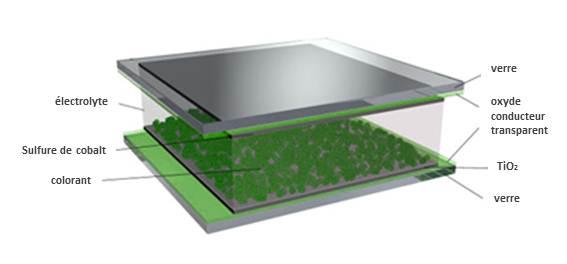+EFFICIENT +PROFITABLE +ECOLOGICAL
Solar energy is one of the most promising alternatives to fossil fuels. The challenge, however, lies in developing cells whose performance is sufficient to make this solution economically viable. One promising strategy – the Grätzel cell – involves the generation of a current following the stimulation of a dye adsorbed on TiO2 nanoparticles, into which electrons are injected and transferred to an exterior circuit. This elegant strategy must undergo modifications in terms of materials used, in order to make the Grätzel cell more attractive, notably when targeted applications require the production of cells with a large surface area. For example:
- The electrolyte used is based on I- and I3– ions, whose mix, in large concentrations, is colourful and corrosive to the cathodic material as well as the silver-based electrical contacts;
- The cathodic catalyst is based on platinum, an expensive material.
Prof. Marsan’s team developed an effective, transparent and non-corrosive organic electrolyte. Furthermore, the platinum electrode was replaced by a less expensive, more stable high-performance material: cobalt sulfide.
Given its tremendous potential, this was recognized as one of the 10 most important discoveries of 2010 in Quebec, and published in the prestigious magazine Nature Chemistry.
REFERENCE
[1] M. Wang, N. Chamberland, L. Breau, J.-E. Moser, R. Humphry-Baker, B. Marsan, S. M. Zakeeruddin, M. Grätzel, Nature Chemistry, 2, 385-389 (2010)
RESEARCHER
Pof. B. Marsan and Prof L. Breau (UQAM)
IRDQ CONTRIBUTION
